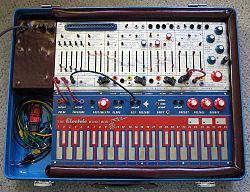Main signal path
Oscillators
The oscillator section contains a two VCOs that can only produce a triangle wave. The oscillators are set up in a modulator-carrier relationship to perform FM synthesis. The modulator is usually silent (though it can be heard through patching) and its pitch is determined by a ratio to the carrier pitch, controlled by the RATIO knob. The depth of frequency modulation is controlled by the MOD knob. [2]
The oscillator section also has a wavefolder, which adds additional harmonics to the complex oscillator by folding the waveform multiple times. The amount of wavefolding is controlled by the FOLD knob. [15]
Low pass gates
The Volca Modular's dual low pass gates (LPGs) are a cross between a Voltage Controlled Amplifier (VCA) and a Voltage Controlled Filter (VCF). This gives the Volca Modular a distinctly natural sound, with sounds becoming both brighter and louder as cutoff increases. Unlike a typical VCF, they do not have resonance and are unable to self-oscillate. The only control for the LPGs is the CUTOFF knob, which controls the cutoff of each LPG individually. [16]
Space out
Space out is a digital reverb, the only digital part of the Volca Modular. It is distinctly digital and cold but, according to MusicRadar "without it, the Volca Modular can sound dry and lifeless". Its only control is the AMOUNT knob, which controls the wet/dry signal mix. [1]
Modulators and utilities
Function generators
The Volca Modular has 2 function generators, each behaving slightly differently. The first function generator is an attack-hold-release envelope (AHR as opposed to the more standardized ADSR). The attack and decay stages are both exponential curves, with the attack being inverted. The ASR envelope's has two knobs for hands-on control of the ATTACK and RELEASE.
The other function generator on the Volca Modular is ramp shaped, with no control over the individual portions of the envelope. The shape of this generator goes between a sawtooth, blended towards a triangle and then to a reverse sawtooth, or ramp. This blend is controlled by the SHAPE knob. There is also control of the time the generator takes from start to finish via the TIME knob. Using patching, this function generator can be made to function like a standard LFO. [15]
Utility
The Utility module uses two simple equations to attenuate and mix signals: a+b*c and a-b*c (where c is the knob marked "c"). This can be used in many ways, including as a rudimentary method of summation or a basic ring modulator. [15]
Woggle
The "Woggle" on the Volca Modular is a sample and hold circuit, which provides random values via sampling pink noise. It has both smoothed and stepped outputs. The internal pink noise sampling can be overridden, allowing you to sample any output of the Volca Modular. [2]
Mult/Split
The split module is a utility that allows you to a turn one signal into two identical copies, useful for when you want to route a modulator to multiple destinations. There are two independent signal splitters. [15]
Clock divider
The Volca Modular's clock divider section gives out trigger pulses in divisions of the tempo of the sequencer (tempo is controlled by the TEMPO knob). Divisions of every fourth, third and second are available, as well as a general gate output. [15]

